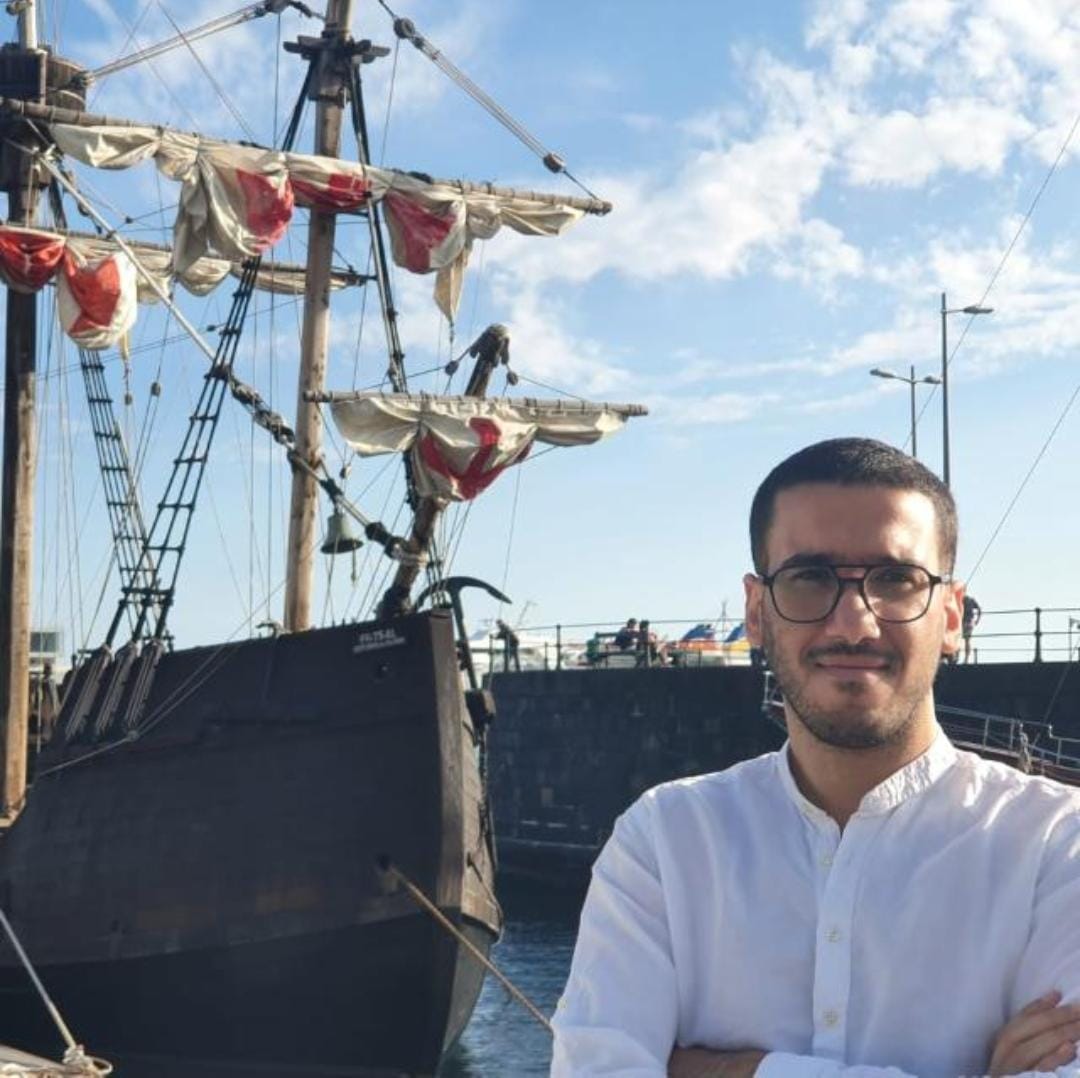Portugal, located in the southwest of the European continent, boasts a rich cultural and geographical diversity. Encompassing the mainland of the Iberian Peninsula, the country also includes the Azores and the Madeira archipelago in the Atlantic Ocean. Portugal is flanked by the Atlantic Ocean to the west and south, and shares its land borders to the north and east only with Spain.
As of 2023, Portugal has a total population of approximately 10.245.094 people. The country spans a total area of 92,212 square kilometers, making it a relatively compact nation. Lisbon, known for its steep hills and picturesque vistas, serves as the capital and also the largest city of Portugal.
Officially referred to as the Portuguese Republic, Portugal is a unitary republic. It follows a semi-presidential system of governance, striking a balance between the powers of the President and the Parliament.
Portugal is located in the southwest of the European continent, primarily bordered by the Atlantic Ocean. The country’s highest peak is Mount Pico on the Azores, while Serra da Estrela is the highest point on the mainland. The Tejo River, Portugal’s most vital waterway, flows through the heart of the country. The Buçaco National Forest and Lake Alqueva, Portugal’s largest lake, are other noteworthy geographical features.
Below is an image showing Porrtugal’s position in the world.
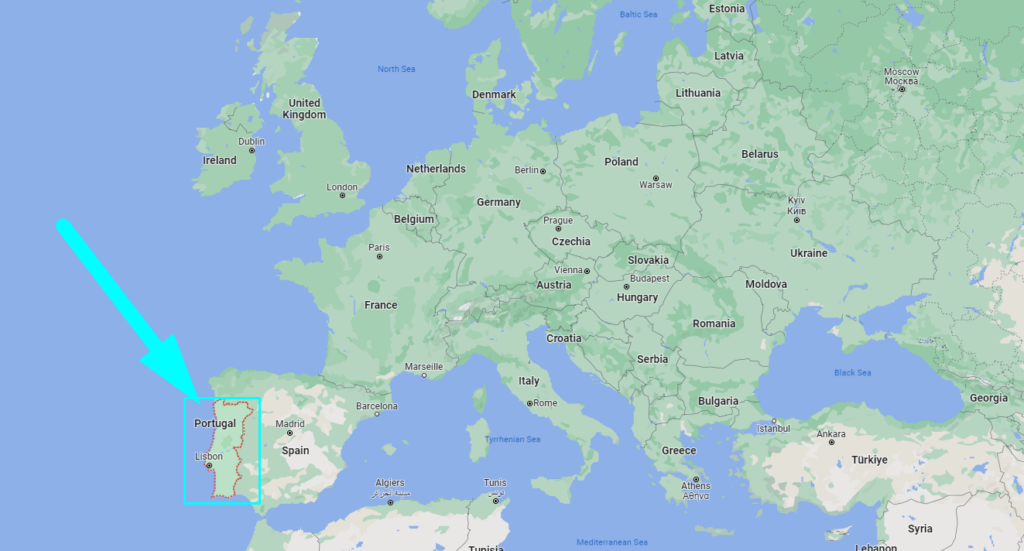
Portugal sits between 30° and 42° north latitude and 32° and 6° west longitude, situating it in the Northern and Western Hemispheres.
While Portugal shares many cultural and climatic similarities with Mediterranean countries, it is not classified as one. The country only has a coast on the Atlantic Ocean.
Portugal shares its land borders with Spain to the north and east. While it doesn’t have a physical border with Morocco, a maritime boundary exists to the south across the Strait of Gibraltar.
Portugal has a total border length of 2,046 kilometers, divided between its land border with Spain (1,214 kilometers) and its Atlantic Ocean coastline (832 kilometers).
Portugal occupies a total area of 92,212 square kilometers, making it the 111th largest country in the world and the 19th largest in Europe.
The political map of Portugal below illustrates the country’s borders, neighboring countries, and its internal divisions into regions, provinces, cities, and two autonomous regions – the Azores and Madeira.
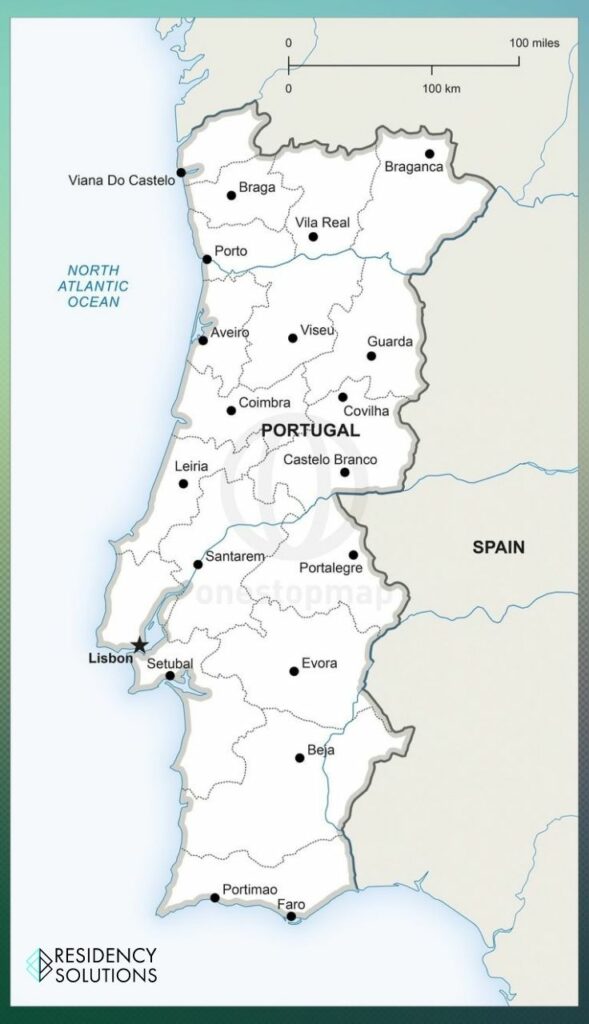
Portugal is composed of several regions, each with unique characteristics:
The autonomous regions of Azores and Madeira enjoy a degree of political and administrative autonomy, giving them unique cultural identities within the broader Portuguese context.
Portugal’s multifaceted geographical, cultural, and political landscapes make it a compelling country to discover, a blend of rich historical narratives, and dynamic modern developments.
Portugal, a country rich in history and culture, is divided into various provinces, each with its distinct character and charm. Here, we delve into the details of some of the provinces of Portugal.
Portugal is home to 159 cities, each contributing to the country’s rich cultural tapestry. The largest cities are:
Several other cities like Coimbra, Queluz, Funchal, Cacem, Vila Nova de Gaia, Algueirao, Loures, Felgueiras, Evora, Rio de Mouro, Odivelas, Aveiro, Amora, Queluz, Almada, Agualva Cacem, Gondomar, Rio Tinto, Povoa de Varzim, and Matosinhos add to the diverse urban fabric of Portugal.
Portugal has a total of 159 cities.
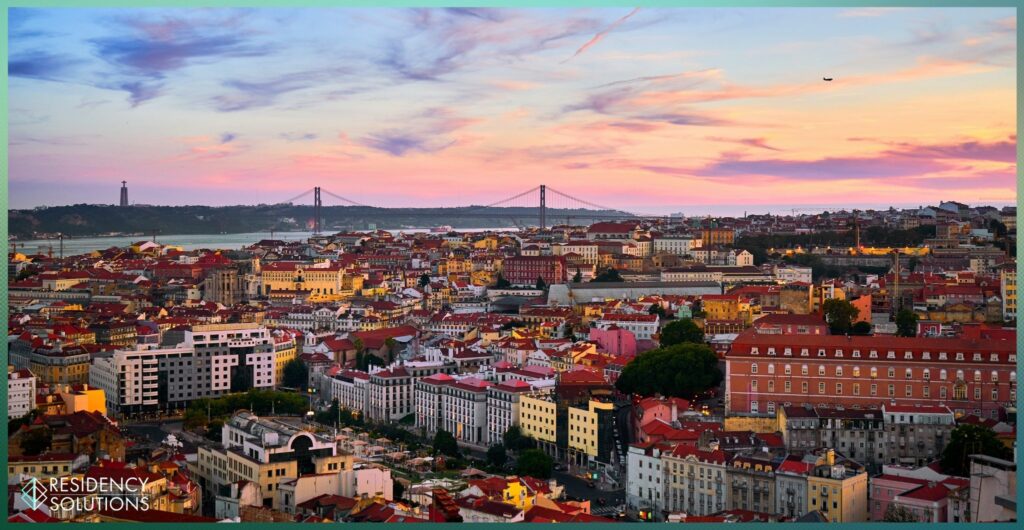
Lisbon is the capital of Portugal. With a population of approximately 544,851 people, it sprawls over an area of 100.05 square kilometers. Situated in the southwestern part of the country, Lisbon is recognized as a global city due to its significance in finance, commerce, media, entertainment, arts, international trade, education, and tourism.
Lisbon is located in the southwestern part of Portugal, surrounded by the breathtaking scenery of the Tagus Estuary and River, and the rolling landscapes of the Sintra Mountains.
Mainland Portugal is geographically diverse. In the north, the landscape is mountainous, structured by terraces and valleys, while the south is characterized by rolling plains. The country’s largest river, the Tagus, splits the country into distinct topographical regions. Furthermore, Portugal includes the picturesque Algarve and Alentejo regions, and two archipelagos in the Atlantic Ocean – Madeira and the Azores.
A physical map of Portugal displays the land formations, such as mountains, plains, and rivers. It shows the diverse geographical features from the elevated heights of Serra da Estrela to the sprawling plains in Alentejo, and from the sandy beaches of Algarve to the verdant vineyards in Douro.
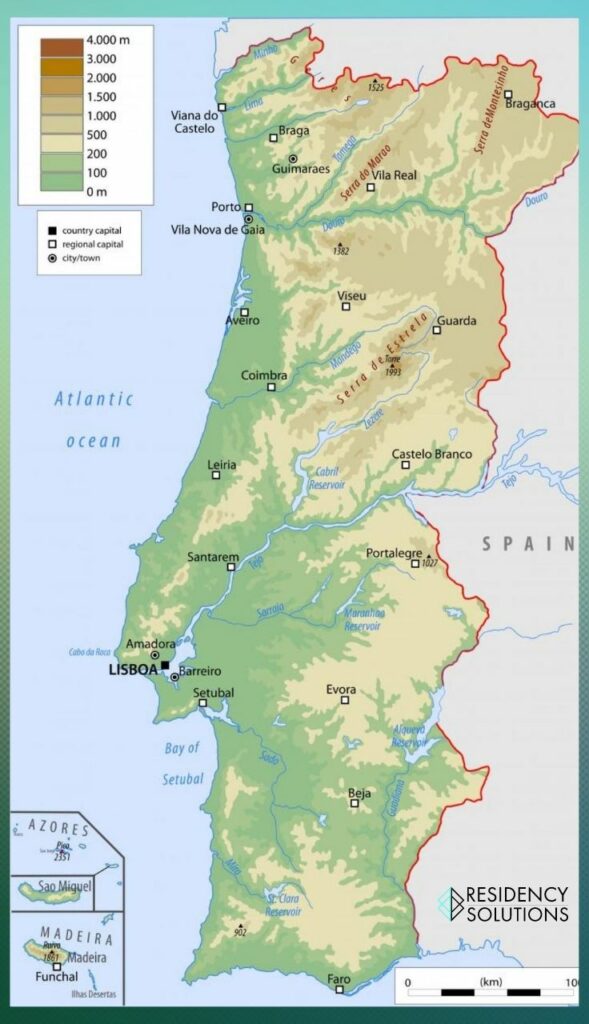
Portugal’s highest point is Mount Pico, which reaches an impressive 2,351 meters above sea level. Located in the Azores archipelago, it’s a dormant stratovolcano that offers spectacular views.

Portugal’s largest lake is Lake Alqueva. Located in the Alentejo Region, the lake stretches for 83 kilometers and covers an area of 250 square kilometers. It’s a crucial water reservoir and a popular recreational area.
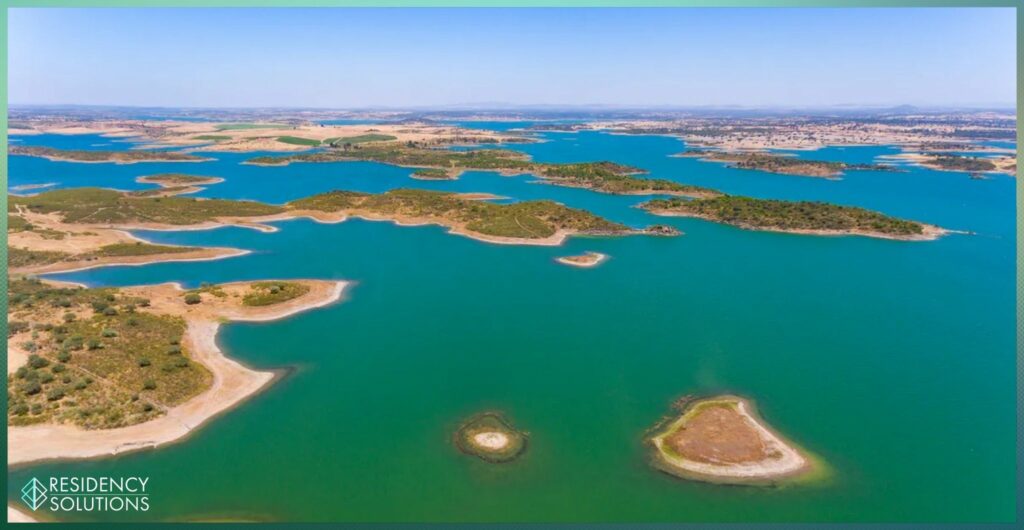
The Tejo River, with a length of 1,007 kilometers, is Portugal’s longest river. It flows through several Portuguese cities, including Santarem and the capital, Lisbon, before emptying into the Atlantic Ocean.
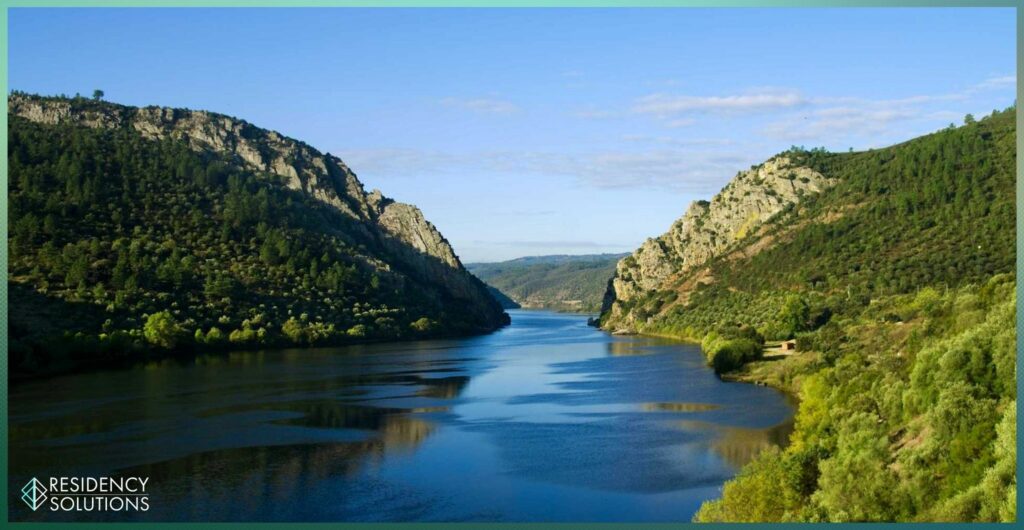
Portugal experiences diverse climate types. The coastal regions have a Mediterranean climate with warm, dry summers and mild, rainy winters. The northwest experiences a temperate maritime climate, while certain parts of the Beja region have a semi-arid climate. The Azores experience a humid tropical climate, and the Selvagens Islands have a warm desert climate.
According to the Worldometer data for 2023, the population of Portugal is approximately 10.24 million people. Which is equivalent to 0.13% of the world population. Portugal therefore ranks number 93 in the world for most population.
Around 95% of the Portuguese population is ethnically Portuguese. The country is religiously homogeneous, with most of the population following Catholicism. Portuguese is the main language spoken in the country, except in the Miranda do Douro region, where the Miranda language is recognized as co-official.
Portugal also hosts various foreign communities, including Ukrainians, Moldovans, Romanians, Russians, Bulgarians, Brazilians, Venezuelans, and immigrants from Portuguese-speaking African countries.
In Portugal, a variety of languages are spoken due to its culturally diverse and globalized society. Portuguese remains the dominant language, spoken by 95.6% of the population. This is followed by English, French, and Spanish, which are spoken by 14.87%, 10.39%, and 6.98% of the population respectively.
Additionally, languages such as German, Estonian, and Czech can also be found, albeit to a lesser extent.
This linguistic diversity can be attributed to Portugal’s strong tourism industry, international ties, and high standard of education, which encourages multilingualism. Especially among the younger generations, these languages are well understood and often spoken, aiding Portugal in maintaining its global interconnectedness.
The official language of Portugal is Portuguese. This Romance language is one of the most spoken languages in the world due to the historic Portuguese Empire, and its influence can be seen in various countries across the globe.
Apart from Portuguese, some municipalities, such as Miranda do Douro, recognize the Mirandese language as a second official language. The use of Mirandese, however, is limited to certain regional and local contexts.
Religion significantly influences Portuguese culture, with the majority of the population, approximately 81%, identifying as Roman Catholic.
There are other Christian denominations represented in Portugal, including:
These other Christian denominations together constitute about 3.3% of the population.
Minority religions in Portugal account for 0.6% of the populace and include:
These religions are primarily practiced by immigrants and their descendants.
A significant part of the population identifies as agnostic, atheist, or does not belong to any specific religion, amounting to 6.6%. Furthermore, 8.3% of the population did not specify their religious affiliation.
While the majority of the population in the Portuguese Republic is Roman Catholic, it is important to note that there is no official religion in the country, reflecting the nation’s commitment to religious freedom and pluralism.
Portuguese history is rich and spans thousands of years, marked by significant events. Here are the 15 most notable historical events in Portugal:
These historical milestones encapsulate the rich and diverse heritage of Portugal, which can be traced back to the Celts in the years before Christ.
The Portuguese Republic was established on October 5, 1910. This significant event marked the overthrow of the constitutional monarchy in Portugal and the end of the reign of King Manuel II, leading to the establishment of the First Portuguese Republic.
The national flag of the Portuguese Republic is rectangular, with a 2:3 ratio. The flag is composed of two vertical bands of green and red, with the green band situated at the hoist side. Overlapping the boundary of these two colors is the coat of arms of Portugal. This emblem includes the country’s traditional shield and an armillary sphere. The flag encompasses several colors, including green, red, yellow, blue, and white.
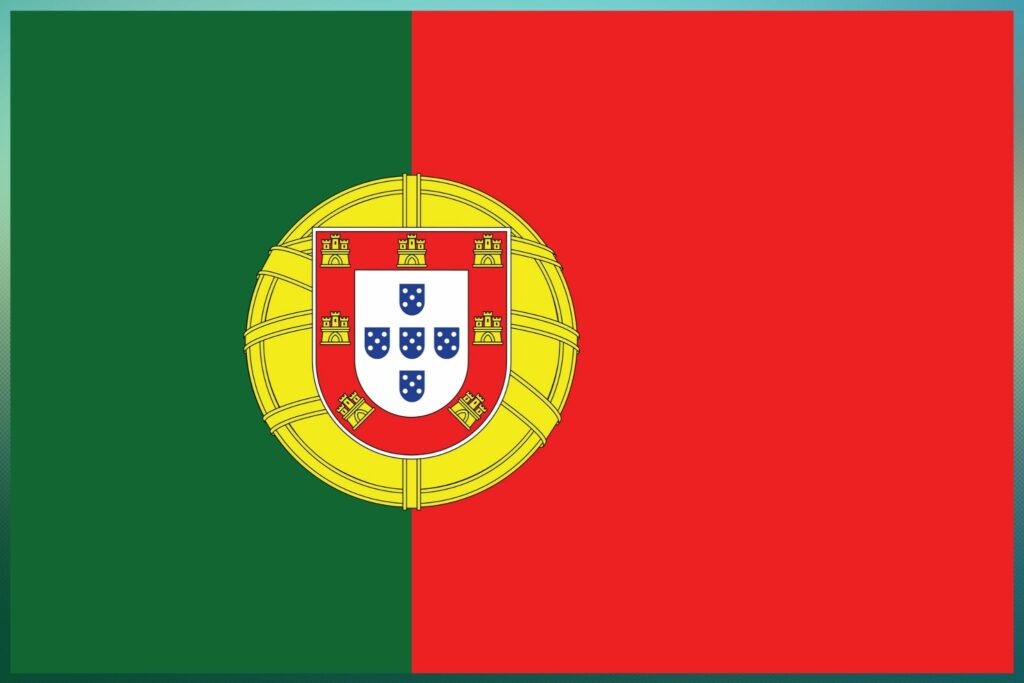
The symbolism within the flag is profound. The green represents hope for the future, while the red stands for the bloodshed by those who fought for the nation. The armillary sphere pays homage to Portugal’s influential role in the Age of Discoveries, while the coat of arms reflects on the nation’s medieval history.
Portugal, shaped by the 1976 Constitution, operates under a democratic republic with a semi-presidential system. The political structure is divided into four sovereign bodies as specified by the Constitution: the President, the Government, the Parliament of the Republic, and the Courts.
The President of the Republic is the head of state, while the Government, led by the Prime Minister, is the executive body. The Parliament of the Republic is a single-chamber legislative body known as the Assembly of the Republic.
The Courts represent the judicial branch, responsible for upholding the constitution and laws of Portugal. Since the ratification of the 1976 Constitution, Portugal has firmly established its democratic values and principles.
Yes, Portugal has been a member of the European Union since January 1, 1986. The majority of the Portuguese population supported the nation’s accession to the EU, which has brought about numerous significant benefits. These include freedom, prosperity, security, and the ability to move freely, live and work without restrictions throughout the member countries of the EU.
Additionally, Portugal has gained access to a single market and cohesion funds for economic development, which, along with a framework for legislative and social standards, has contributed to improvements in the nation’s economy, infrastructure, and quality of life for its residents.
Yes, Portugal is a Schengen country, having been a member of the Schengen Agreement since March 26, 1995. The advantages of being part of the Schengen Area are numerous.
It has enabled Portugal to become part of the largest free travel zone, thereby abolishing internal border controls and allowing free movement between member states. This agreement has significantly fostered closer economic and commercial relations with Europe, promoting trade, tourism, and strengthening the bond between European nations.
The Portuguese military force, known as the Portuguese Armed Forces, is divided into three branches: the Land Forces, the Navy, and the Air Force. The President of Portugal is the official Commander-in-Chief of the Armed Forces.
The Portuguese military is a voluntary service, with an active personnel number of 32,992, of which 12% are women. The minimum age for military service in Portugal is 18. The Armed Forces are responsible for Portugal’s defense and participate in international peacekeeping missions under NATO and the United Nations.
Portugal’s economy is classified as developed and high-income, with a high per capita GDP. Since Portugal joined the European Union, the economy has grown significantly. This growth is marked by improvements in both infrastructure and living standards.
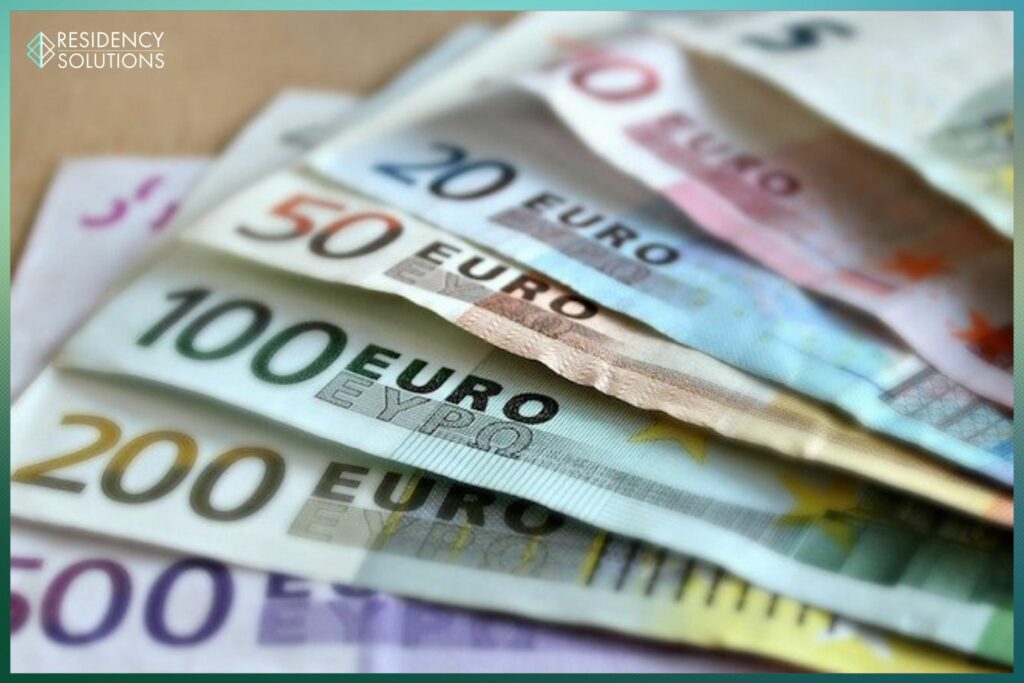
Key sectors contributing to the Portuguese economy encompass a diverse range of industries. These include textile, clothing, footwear, wood and cork, paper, chemicals, auto parts manufacturing, and base metals. Portugal also thrives in the production of dairy products, wine and other foods, as well as in the porcelain and ceramics sector. Other notable industries include glassware, technology, telecommunications, shipbuilding and renovation, and building materials.
In addition to these sectors, the service industry, especially tourism, has played an increasingly important role in the nation’s economy. It attracts millions of visitors annually, significantly contributing to the nation’s economic growth.
The official currency of Portugal is the Euro (€), which it adopted in 2002 when it joined the Eurozone. As part of the European Union, Portugal was one of the first nations to adopt the euro, replacing the Portuguese Escudo.
As of the latest available data in 2023, the minimum monthly wage in Portugal is €760. The minimum wage in Portugal is regularly updated in accordance with changes in the cost of living and economic performance.
According to the latest available data from the World Bank, Portugal’s national income per capita, measured in gross national income (GNI) per capita, is $24.274.5.
The unemployment rate stands at 7.2% in 2023 according to the latest study. The unemployment rate in Portugal fluctuates due to various economic factors.
In Portugal, the health system is a mix of public and private services, with the state bearing the responsibility for ensuring access to healthcare for all residents. Services are provided through a multitude of avenues, including public hospitals and private facilities. While health services in Portuguese public hospitals are generally free of charge, recent years have seen the introduction of some fees for certain services.
Portugal’s healthcare system is renowned for its quality, achieving a high standard that is reflected in its ranking as the 13th best in the 2018 Euro Health Consumer Index. This speaks volumes about the system’s efficiency and patient satisfaction levels.
The healthcare system in Portugal comprises three coexisting systems; the National Health Service, private health insurance, and private social health insurance systems. The latter caters to those working in the public sector. In addition to the public options, private healthcare options are available and often offer shorter wait times for non-urgent procedures.
The education system in Portugal is primarily state-funded and is mandatory for all children aged between 6 and 18. It prides itself on providing high-quality education, having been ranked 24th in the Education Rankings by Country for 2023.
The Portuguese education system is divided into four stages:
Portugal boasts numerous world-class universities, with the Portuguese Catholic University holding the highest rank in the World University Rankings of 2023. Other top Portuguese universities include:
These universities offer a diverse range of courses, attracting students from all around the world.
Portuguese cultural heritage is renowned for its richness and diversity. It’s characterized by a traditional infrastructure that varies regionally. Every city and town in Portugal boasts a unique collection of cultural venues – including museums, ancient monuments, and historical buildings – which add a touch of antiquity to the contemporary landscape.
No town in Portugal is without at least one cinema, offering an array of films from around the world. These venues play a significant role in the local cultural landscape, providing a platform for both international and Portuguese cinema.
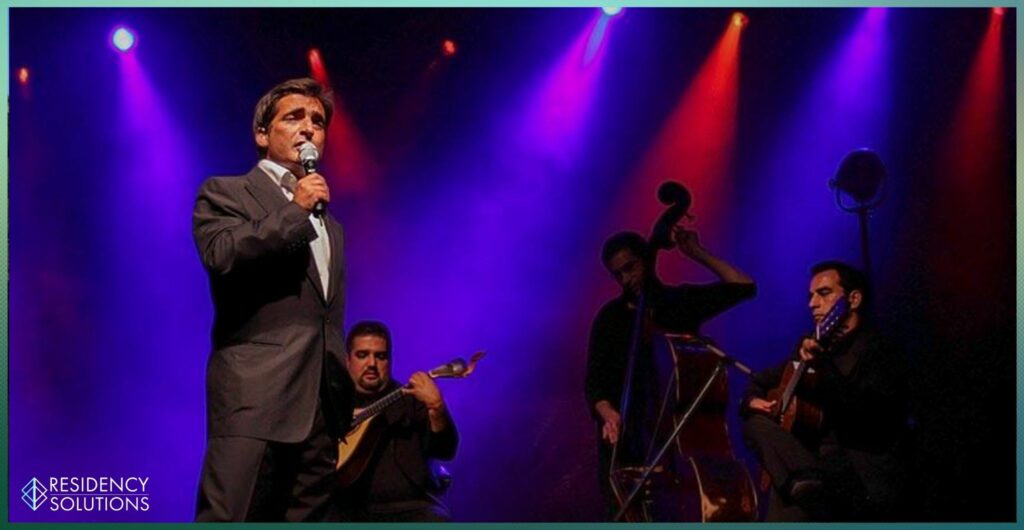
Similarly, there are numerous music venues across the country. From traditional Fado houses to modern concert halls, these venues represent the country’s diverse music culture.
The richness of the country’s cultural heritage is also reflected in its arts and crafts centers. These spaces showcase the creative talent of Portuguese artisans and provide a glimpse into the country’s artistic traditions.
This distinctive culture is a testament to Portugal’s historical role as a significant player in the Age of Discovery. Having connected with civilizations across the Mediterranean and the European continent, Portuguese culture has emerged as a rich tapestry, weaving together influencef20s from numerous civilizations over the past millennium.
Portuguese cuisine is distinctive and diverse, characterized by a notable emphasis on the consumption of dried cod, or “bacalhau”. Central to the majority of the dishes are ingredients like onions, garlic, potatoes, tomatoes, peppers, parsley, and a range of meats that include beef, pork, lamb, goat, and chicken.
Among the traditional dishes in Portugal, Caldo verde soup is a popular choice. This green broth is a staple of Portuguese kitchens and often served as a starter or a late-night snack.
Another dish widely consumed is Bacalhau. With hundreds of recipes for this fish dish across Portugal, it’s a true testament to the country’s love for dried cod.
The National Portuguese sandwiches are also noteworthy. These sandwiches, packed with various meats and flavors, offer a taste of Portuguese street food.

A unique dish from Portugal is Francesinha. This meaty sandwich layered with different kinds of meat, covered with melted cheese, and soaked in a tomato and beer sauce, is a delicacy particularly in Porto.
In the realm of Portuguese poultry dishes, Piri piri chicken stands out. It’s a spicy grilled chicken dish, marinated in piri piri sauce, that reflects Portugal’s historical connections with Africa.
Turning to desserts, Pastel de nata is a renowned Portuguese pastry. These egg custard tarts, often dusted with cinnamon, have become a symbol of Portuguese sweets worldwide.
Lastly, Pao de lo is a traditional sponge cake dessert, known for its moist center. It’s a classic representation of the country’s rich and varied dessert offerings.
The Portuguese music culture is diverse, comprising a wide variety of genres. Most prominent among these is the traditional fado music, which utilizes an assortment of instruments. The instruments include bagpipes, drums, flutes, tambourines, accordions, and ukuleles.
Rooted deeply in local customs and traditions, fado has been recognized as Portuguese folk music. Its significance in Portuguese culture led to its inclusion in the World’s Intangible Cultural Heritage list by UNESCO.
Another key element of Portuguese music is the Alentejo music genre. This musical tradition persists in the southern province of Alentejo, resonating with the local culture and lifestyle.
In the northeastern mountainous region of Portugal, specifically Tras os Montes, the regional Portuguese music offers a unique sonic experience reflecting the area’s distinct cultural expressions.
Lastly, the Ranchos Folcloricos music is common in many Portuguese towns and villages, providing a tuneful narrative of their folk traditions.
The heritage of Portuguese cinema: Dates back to the dawn of the medium in the late 19th century. The initiation of Portuguese cinema occurred in 1896, following the exposure to foreign films.
The first cinema in Portugal: Opened its doors in 1904, coinciding with the creation of the country’s first film, “Saida do Pessoal Operario da Fabrica Confiança.” This momentous event was pivotal in shaping the future of cinema culture in Portugal.
Noteworthy Portuguese films: Include the first scripted Portuguese film “O Rapto de Uma Actriz,” the first sound film “A Severa,” and the first feature film “Aniki Bobo.”
Portuguese literature is predominantly crafted in the Portuguese language and penned by Portuguese citizens. It has been distinctively marked by a rich and diverse lyric poetry, a feature that has been a part of its essence since the language’s inception following the Roman occupation.
Key works that trace the journey of Portuguese literature from the past to the present include:
Portugal has given rise to a wealth of famous personalities who have left their mark in various domains.
In the realm of sports, footballers Cristiano Ronaldo and Ricardo Quaresma are renowned figures who have written their names in the annals of history.
Notable political figures include Antonio de Oliveira Salazar and Afonso I, who have made significant contributions in their field.
Amalia Rodrigues, a celebrated singer, is a standout in the field of music.
In the literary world, Jose Saramago and Fernando Pessoa are illustrious writers who have gained global recognition.
The lifestyle in Portugal is distinctive, harmoniously melding both traditional and contemporary aspects. While sharing some similarities with neighboring Spain, the Portuguese way of life is largely uninfluenced by Spain.
Regional variations in the lifestyle do exist, but there is less regionalism throughout Portugal compared to Spain. Over time, the lifestyle has evolved significantly due to the urban expansion and the diminishing rural population.
Portugal is famous for various products and places such as:
Tourist destinations in Portugal are vast and diverse, including:
The most popular cities to visit in Portugal include Lisbon, Sintra, Porto, Evora, and Obidos.
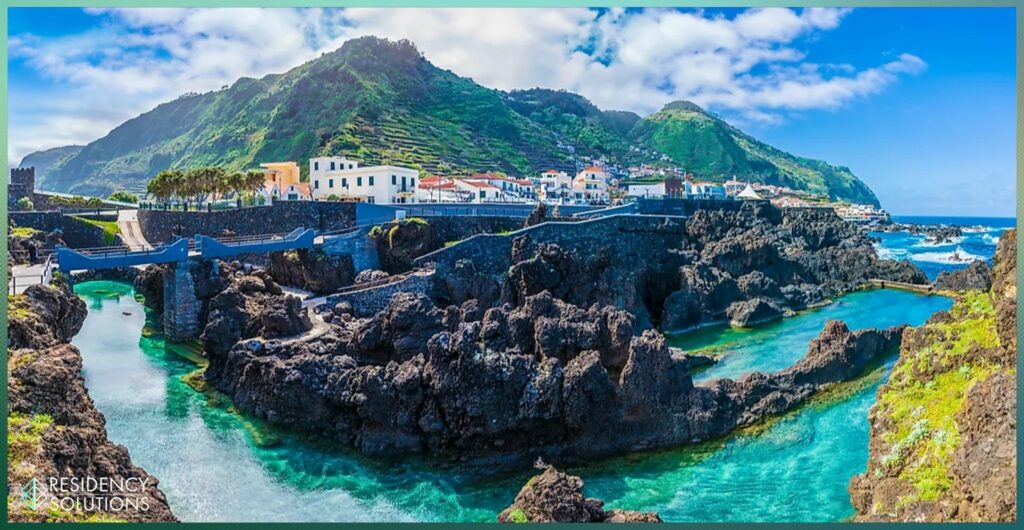
Portugal operates in the (GMT+1) time zone.
The dialing code for Portugal is +351.
In Portugal, the vehicle registration plates, commonly referred to as ‘license plates,’ are distinguished by the letter “P.” In 2020, the Portuguese government introduced a new license plate system, transitioning from the format “00-AA-00” to “AA-01-AA.”
This change signifies that the system is no longer based on geographic locations, but rather follows an incremental numbering system. Portuguese license plates are typically printed in black characters on a white rectangular plate.
The image below shows the evolution of vehicle registration plates from 1992 to 2023.

The top-level domain for Portugal is “.pt.” As of 2023, there are 1.727.103 active domains with the “.pt” domain extension. Notably, the process of obtaining a “.pt” domain extension is straightforward and does not require any special documents or authorization.
The international abbreviation for Portuguese is “PT.” This abbreviation is used in a variety of contexts, such as language designation, international coding standards, and more.
Portugal, with its mesmerizing landscapes and rich culture, promises an unforgettable journey for travelers. To ensure a seamless experience, travelers should be aware of certain essentials before venturing to this Iberian nation.
Before boarding your flight or crossing the border into Portugal, ensure you have:
Below, we’ll give you the suitable visas for foreigners that need to get a visa to enter Portugal.
What is the D7 Visa?
The D7, commonly termed the “Portugal retirement visa,” is designed for financially independent individuals, allowing them to reside in Portugal without the need to work.
Key Benefits & Eligibility of the D7 Visa
Benefits include free circulation within the Schengen Area, potential tax advantages, and access to Portuguese amenities like healthcare and education. To be eligible, one must have a clean criminal record, earn a passive income of at least €7,200 annually, and deposit around €9,000 in a Portuguese bank.
Learn More About The Portugal D7 Visa
For a comprehensive breakdown of the D7 visa, from application to benefits, visit our D7 Visa service page.
Introduction to the D2 Visa The Portugal D2 Entrepreneur Visa, designed for non-EU/EEA/Swiss investors, offers an opportunity for entrepreneurs eager to set their base in Portugal. Whether you’ve already invested or have intentions of doing so in the Portuguese landscape, the D2 Visa streamlines your residence authorization process.
Key Features of the D2 Visa
Benefits You Can Reap
With the D2 Visa, you aren’t just getting residence rights; you’re unlocking a range of benefits. This includes free movement within the Schengen Area, an option for family reunification in Portugal, potential tax advantages through the Non-Habitual Resident (NHR) regime, and a pathway to permanent residency or citizenship. Plus, as a resident, you gain access to Portugal’s public health and education systems.
Taking the Next Steps
Securing the D2 Visa involves a sequence of steps starting from obtaining a Portugal taxpayer identification number, ensuring accommodation, applying online, and gathering the essential documents. While the government fees are minimal, ensuring a seamless application often requires professional guidance.
For an in-depth understanding, detailed requirements, and assistance with your application, consider exploring our D2 Visa service page. Our dedicated team ensures that your entrepreneurial journey in Portugal begins on the right foot.
What Is the D8 Visa?
A fast-track gateway for digital nomads, freelancers, and remote workers from non-EU/EEA/Swiss countries to reside in Portugal. With Portugal’s growing appeal to the digital community, the D8 was introduced as a tailored solution, offering both temporary and long-term residence options.
Key Requirements:
Steps to Obtain the D8 Visa:
Why Choose the D8 Visa?
Portugal’s rich cultural tapestry combined with the flexibility of the Digital Nomad Visa offers a unique work-life blend. Navigating visa procedures can be challenging, but our team is here to guide you. For a comprehensive understanding and assistance on the D8 Visa, explore our Digital Nomad Visa service page.
A ticket to employment opportunities in Portugal, the Job Seeker Visa, unfolds in various facets:
Duration & Flexibility
This visa grants entry for 120 days or 4 months, but if you’re on the cusp of sealing a job offer, you might be eligible for an additional 60-day grace period.
What Happens Next?
Found a job within the visa period? Great! You can then march straight into applying for a residence permit. If the wind doesn’t blow in your favor? You might need to exit Portugal but get another chance a year later.
Key Documents Checklist
Preparation is half the battle won. Equip yourself with:
For an in-depth dive, do make a pit stop at our exhaustive service page on Job Seeker Visa.
